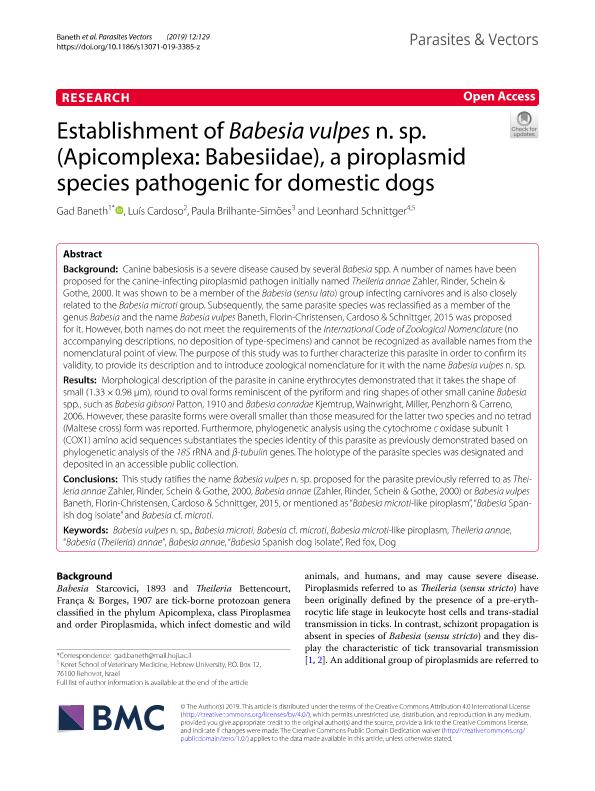Artículo
Establishment of Babesia vulpes n. sp. (Apicomplexa: Babesiidae), a piroplasmid species pathogenic for domestic dogs
Fecha de publicación:
26/03/2019
Editorial:
BioMed Central
Revista:
Parasites and Vectors
ISSN:
1756-3305
Idioma:
Inglés
Tipo de recurso:
Artículo publicado
Clasificación temática:
Resumen
Background: Canine babesiosis is a severe disease caused by several Babesia spp. A number of names have been proposed for the canine-infecting piroplasmid pathogen initially named Theileria annae Zahler, Rinder, Schein & Gothe, 2000. It was shown to be a member of the Babesia (sensu lato) group infecting carnivores and is also closely related to the Babesia microti group. Subsequently, the same parasite species was reclassifed as a member of the genus Babesia and the name Babesia vulpes Baneth, Florin-Christensen, Cardoso & Schnittger, 2015 was proposed for it. However, both names do not meet the requirements of the International Code of Zoological Nomenclature (no accompanying descriptions, no deposition of type-specimens) and cannot be recognized as available names from the nomenclatural point of view. The purpose of this study was to further characterize this parasite in order to confrm its validity, to provide its description and to introduce zoological nomenclature for it with the name Babesia vulpes n. sp. Results: Morphological description of the parasite in canine erythrocytes demonstrated that it takes the shape of small (1.33×0.98 µm), round to oval forms reminiscent of the pyriform and ring shapes of other small canine Babesia spp., such as Babesia gibsoni Patton, 1910 and Babesia conradae Kjemtrup, Wainwright, Miller, Penzhorn & Carreno, 2006. However, these parasite forms were overall smaller than those measured for the latter two species and no tetrad (Maltese cross) form was reported. Furthermore, phylogenetic analysis using the cytochrome c oxidase subunit 1 (COX1) amino acid sequences substantiates the species identity of this parasite as previously demonstrated based on phylogenetic analysis of the 18S rRNA and β-tubulin genes. The holotype of the parasite species was designated and deposited in an accessible public collection. Conclusions: This study ratifes the name Babesia vulpes n. sp. proposed for the parasite previously referred to as Theileria annae Zahler, Rinder, Schein & Gothe, 2000, Babesia annae (Zahler, Rinder, Schein & Gothe, 2000) or Babesia vulpes Baneth, Florin-Christensen, Cardoso & Schnittger, 2015, or mentioned as “Babesia microti-like piroplasm”, “Babesia Span‑ ish dog isolate” and Babesia cf. microti.
Archivos asociados
Licencia
Identificadores
Colecciones
Articulos (IPVET)
Articulos de INSTITUTO DE PATOBIOLOGIA VETERINARIA
Articulos de INSTITUTO DE PATOBIOLOGIA VETERINARIA
Citación
Baneth, Gad; Cardoso, Luís; Brilhante Simões, Paula; Schnittger, Leonhard; Establishment of Babesia vulpes n. sp. (Apicomplexa: Babesiidae), a piroplasmid species pathogenic for domestic dogs; BioMed Central; Parasites and Vectors; 12; 129; 26-3-2019; 1-8
Compartir
Altmétricas
Items relacionados
Mostrando titulos relacionados por título, autor y tema.
-
Baneth, Gad; Jacobsen, Monica Ofelia ; Cardoso, Luís; Schnittger, Leonhard (BioMed Central, 2015-04)
-
Baneth, Gad; Nachum Biala, Yaarit; Birkenheuer, Adam Joseph; Schreeg, Megan Elizabeth; Prince, Hagar; Jacobsen, Monica Ofelia ; Schnittger, Leonhard ; Aroch, Itamar (BioMed Central, 2020-04)
-
Romero-Salas, Dora; Mira, Anabela ; Mosqueda, Juan; García Vázquez, Zeferino; Hidalgo Ruiz, Mario; Vela, Noot Aditya Ortiz; de León, Adalberto Ángel Pérez; Florín Christensen, Monica; Schnittger, Leonhard (Elsevier Science, 2016-02)




